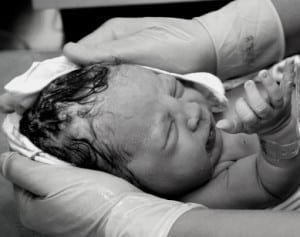
After analyzing the cord blood of three babies born in Toronto and Hamilton, researchers found evidence of 137 different chemicals. Some of the most concerning included flame retardants, lead, organochlorine pesticides, PCBs and PFCs (perflurochemicals), which are found in nonstick coatings. The group says that some of these chemicals have been linked to health conditions like reproductive problems, cancer and developmental problems. Even more unnerving is the fact that some of these chemicals have been banned for decades, which indicates that toxic chemicals persist in both our environment and our bodies, long after they’re gone.
Worst of all, researchers from Environmental Defense say that, because their bodies are so small and they are growing so rapidly, fetuses absorb toxins at a rate much higher than adults. In addition, their “detoxification mechanisms” are less developed as adults, which means that their ability to flush out toxins is less efficient.
“Canadians should have the right to live in a clean, healthy environment,” the authors wrote in their report, titled ‘Pre-Polluted: A Report on Toxic Substances in the Umbilical Cord of Canadian Newborns. “But our tests indicate that before birth, our bodies are already contaminated by hazardous chemicals, some of which have been banned for decades.”
But mothers should blame themselves, Maggie MacDonald, the toxics program manager with Environmental Defense, stressed during an interview with CTV News Channel on Tuesday. These chemicals are so pervasive in our environment, she says, that it would be impossible for moms to completely protect their babies.
“We want to tell mothers it’s not their fault that their babies are being polluted with these toxic chemicals,” she said.
However, there are some things she says we can do to move in a direction that will help future mothers (like our daughters), provide the protection that their children deserve. For example, MacDonald says we should avoid buying products that contain “chemicals of convenience,” like fabrics with stain repellents in them or non-stick cookware.
“That then influences industry to stop using these chemicals in their products,” she said.
In addition, we can sign petitions to have these chemicals banned from our environment. And, governments can do their part by testing chemicals thoroughly before allowing them on the shelves.
“And when it’s decided between scientists and governments that certain chemicals are toxic to humans, clear, strict timelines need to be set so that these chemicals can be eliminated from our lives,” she said.
And for now, Douglas Haines, director of Health Canada’s Chemical Surveillance Bureau, says that parents shouldn’t panic because it’s still too early to tell just how much the exposure actually impacts our children.
“I certainly wouldn’t say it’s cause for panic,” he told CTV News. “The levels that [are] being found are relatively low and the potential impacts are very, very small and subtle.”
Health Canada and scientists at the University of Montreal hope to learn the answer to that with their own environmental study. The goal is to determine the burden of environmental chemicals that mothers and their babies are carrying and what effects (if any) that those chemicals have on the development and growth of the babies. The results are set to be revealed next year.
“We have recruited in 10 cities approximately 2,000 mother-infant pairs,” William Fraser of the University of Montreal told CTV. “The goal of the study is to determine the burden of environmental chemicals that mothers and infants are carrying, and also to access the effects of exposure on infant development and growth.”
Related Articles:
- Home Environment Influences Child’s Obesity Risk, Study Says
- Breastfed Babies Less Anxious and More Likely to Remain Socially Connected, Study Says
- Rare Form of Spina Bifida Causes 10 Centimeter Growth at Base of Infant’s Spine






